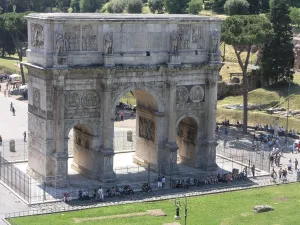- Travel to Rome - Full Guide
- Historical Landmarks
- The Vatican Museums
- Parks and Outdoor Spaces
- Cultural Experiences
- Family Friendly Activities
- Attractions For Children
After enjoying a good Italian beer and endlessly watching the famous Trevi Fountain, move on to a destination you do not want to miss: the Doria Pamphilj Palace, a palace that belonged to the Della Rovere and Aldobrandini families, and since the 1600s to the Doria Pamphilj Landi family.
Doria Pamphilj Palace
The entrance to the Doria Pamphilj Palace is through Via del Corso, no. 305, and the ticket price is 29 euros/adult. Immediately after entering the palace, on the ground floor, you will be greeted by the Diana Room, perhaps the most beautiful room.
So don't rush to discover the hundreds of paintings and sculptures without first delighting your eyes with this impressive room. The museum consists of four impressive Galleries, the family Chapel recently opened to the public, a theater hall, a ballroom, and private apartments.
Walk through the Aldobrandini Gallery, the Hall of Mirrors, or the Doria Pamphilj Gallery, discovering famous works by Caravaggio, Titian, Raphael, Titian Vecellio, Giorgio Vasari, and Velázquez. You might miss some of them, the number being extremely large, and once you reach the last rooms, your concentration capacity might decrease, tired from so much art.
So towards the end of the visit, rather admire the beauty of the interiors and the extraordinary furniture pieces.
Spend more than an hour visiting the Doria Pamphilj Gallery, a time still insufficient to properly cover the multitude of works displayed from floor to ceiling in almost all rooms.
Piazza Venezia
A bit dizzy, head towards Piazza Venezia, one of the most important squares in Rome. Here are the Venezia Palace, the Vittorio Emanuele II Monument, the Bonaparte Palace, the Church of Santa Maria d'Aracoeli, and Trajan's Column, and from here you can quickly reach the Capitoline Museums, the Imperial Forums, or the Roman Forums.
The square is named after the Venetian cardinal Pietro Barbo, the nephew of Pope Eugenius IV, who, upon his appointment as Pope Paul II, ordered the construction of a palace that became the papal residence (especially in summer).
The Venezia Palace was built in 1455 and became the headquarters of the Serenissima (the embassy of the Republic of Venice) starting in 1564. Much of the stone used for the palace's construction was extracted from the nearby Colosseum.
The palace's halls were frequented by cardinals, ambassadors, and Benito Mussolini, who had his office here in the Sala del Mappamondo from 1929-1943. The palace's balcony is known to any tourist from any film about fascism. From this balcony, Mussolini delivered his important speeches. At the end of 2010, Mussolini's most secret bunker, left unfinished, was discovered under the building.
The Vittorio Emanuele II Monument was erected in honor of the king who unified Italy. The building was designed by architect Giuseppe Sacconi. Although construction began in 1885, work continued slowly, and the project was frequently modified. Between 1885-1910, the entire area at the foot of the Capitoline Hill was affected by the new plan, the surrounding neighborhoods were demolished, and the Venezia Palace and the Church of St. Rita were relocated.
If you find the gates open, visit the Museo del Risorgimento, a museum of the history of Italy's unification and formation of modern Italy, located within the Monument. There is no entrance fee to visit these rooms. However, those who want to take a glass elevator to the highest terrace will have to pay 12 euros. Although the panorama from up there is probably incredible, you might prefer to walk on the lower terrace and through the museum before heading to other attractions on your list.
National Museum of Oriental Art
After a pleasant walk through the streets of Rome, near Santa Maria Maggiore, on Via Merulana, no. 248, find the National Museum of Oriental Art, an attraction you shouldn't miss despite limited time.
After admiring the inner courtyard of the palace housing the museum, climb the stairs to the first floor, pay an entrance fee of 6 euros, and start through the rooms containing impressive collections from the Middle and Far East, showcasing Persian ceramics, Tibetan paintings, various Buddhist objects, and many others.
For easier navigation, you will receive a map at the entrance, which you can also find on the official website, and the descriptions are in front of each display case. It will be another highlight of the visit to Rome, entirely different but extremely interesting.
It’s a breath of fresh air, a visit that breaks you away from reality, taking you out of the rooms filled with paintings and reviving you to start again with the tour of other Roman art pieces.
Quattro Fontane
From there, head towards Quattro Fontane, a square surrounded by the four fountains located at the intersection of Via delle Quattro Fontane and Via del Quirinale. The four fountains were commissioned by Pope Sixtus V and represent the river Tiber (symbol of Rome), the river Arno (symbol of Florence), the Goddess Diana, and the Goddess Juno.
The first, second, and fourth fountains are the work of Domenico Fontana, and the fountain representing the Goddess Diana was designed by painter and architect Pietro da Cortona.
Continuing along Via delle Quattro Fontane, arrive at Barberini Palace, today the National Gallery of Ancient Art. Enter the courtyard with palm trees in the middle of which is a non-functional fountain that served as a resting place. You might not enter this Gallery, but the palace exterior seems quite neglected.
Spanish Steps
Continue further along Via Sistina to the famous Spanish Steps and the beautiful Trinità dei Monti church. The steps, perhaps the most beloved Rococo monument in Rome, are covered in May each year with azalea petals – a unique image you can see in most calendars or postcards. The steps were built for King Louis XV by Francesco De Sanctis and are actually called Scalinata della Trinità dei Monti.
At the base of the stairs, Bernini created a boat, "Barcaccia," which seems to be very popular with tourists even though it is not one of the artist's successful works. You might not be impressed by either the boat or the steps, even though they offer a good resting place.
The Park of Museums
Also, make a reservation before arriving in Rome for a visit to the Borghese Galleries, one of the most spectacular private collections in the world. There are enough signs, but to find the Borghese Galleries, you and many other tourists might wander for more than half an hour.
When looking for the Galleries, ask for the "Borghese Galleries" and not Villa Borghese.
The park is an excellent way to spend time if you have enough days in Rome. You can rent bikes with 2 or 4 pairs of pedals or other electric means of transportation. The park is housing, in addition to the famous Borghese Galleries, the National Gallery of Modern Art or the National Etruscan Museum.
There is also a botanical garden and a zoo, two lakes, or an island with the Temple of Aesculapius. Maybe it’s a good idea to reserve at least half a day for this wonderful park. However, if already short on time, after learning that you can’t visit the Borghese Galleries, descend towards Via Veneto.
Via Veneto is perhaps the most famous street in Rome, also brought to the tourists' attention by famous films (see "Dolce Vita" by Federico Fellini). The street became famous in the 1950s-1960s when almost all world celebrities rented rooms in grand hotels and were photographed by paparazzi dining or getting into luxury cars speeding down Via Veneto.
Although it’s hard to come across a celebrity today, the hotels and cafes remain as proof of the bygone days. On this street is also a museum, a Capuchin Crypt, which you might not want to miss. Also, on Via Veneto is the US Embassy.
Perhaps this is the best place to end a vacation in Rome. Even though it’s considered an exclusive street, a glass of wine, once in a lifetime, served on a terrace on Via Veneto probably wouldn’t make you poor.
Following this guide, by now, you have seen many attractions, perhaps missed some. Maybe the weather, the impressive buildings, the multitude of art pieces found both inside the palaces and in squares or on streets, the company of friends, the magnificent churches, museums, parks, will make you declare once you get home that Rome is your favorite city of all you've seen so far.


